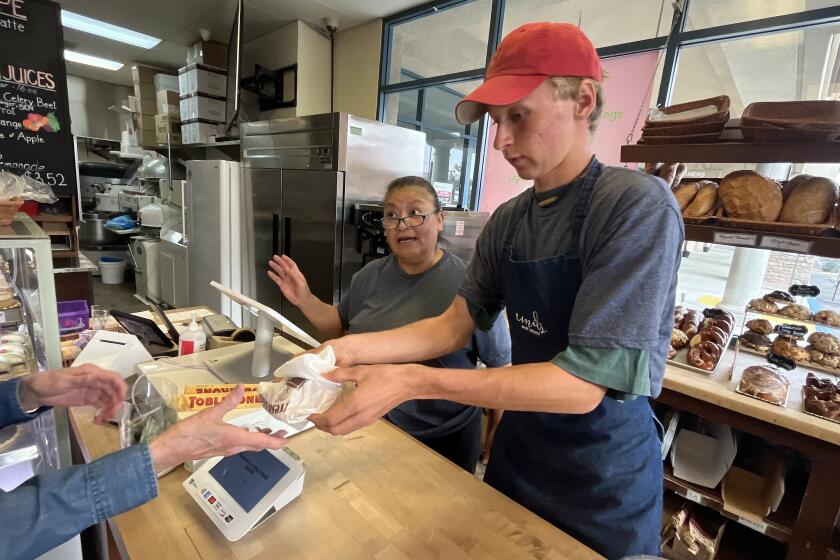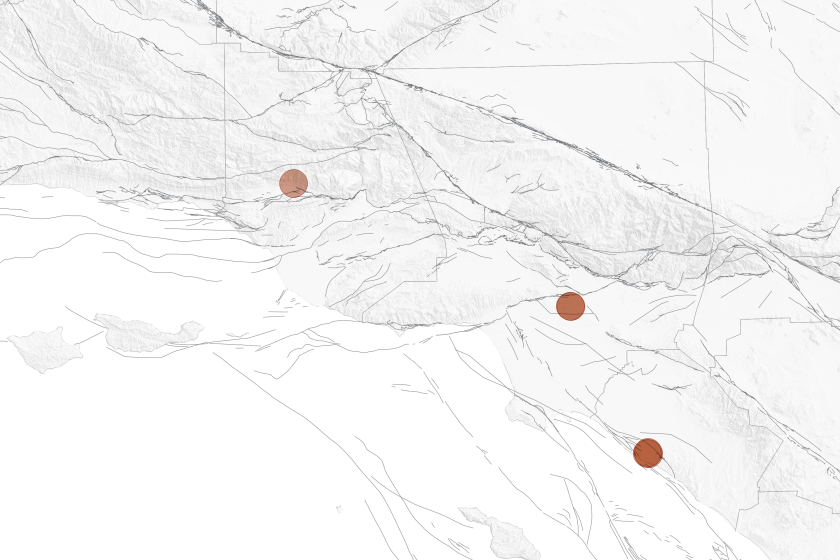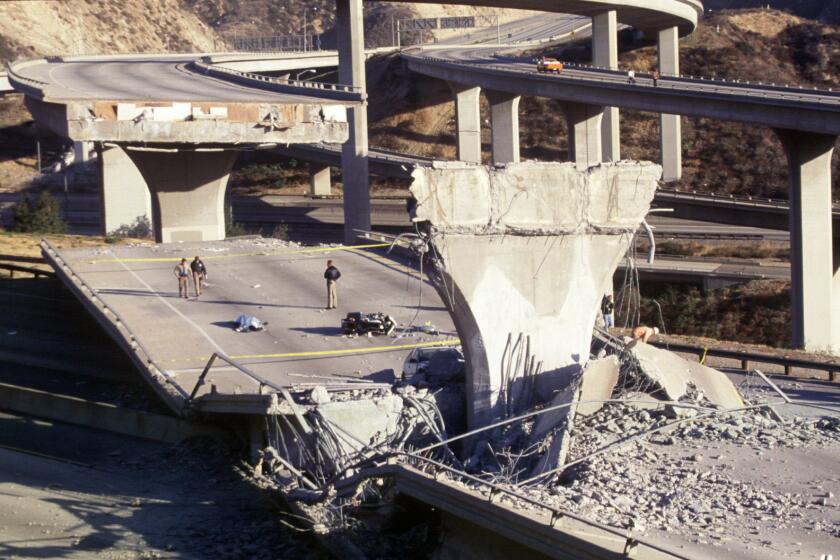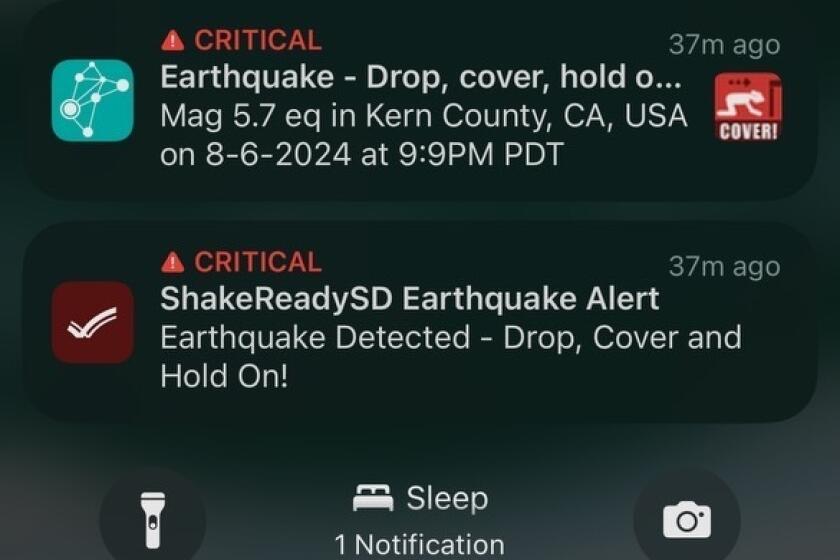L.A.’s quake mystery: 2024 brings the most seismic activity in decades. Why now?

- Share via
- A spate of notable quakes have rattled Southern California in recent months — a reminder that the last three decades of relative seismic quiet won’t last forever.
- California is preparing for the annual ShakeOut earthquake drill, emphasizing the importance of preparedness.
It’s not your imagination: The ground beneath Southern California has been particularly unsteady as of late, with the region experiencing more moderate-sized earthquakes this year than it has in decades.
What precisely is fueling the sequence of shakers is not entirely clear, and officials warn that prior seismic activity does not necessarily mean more powerful temblors are imminent. But the series of modest shakers have many wondering what is going on.
“Earthquakes pop off around the state, and it’s a little bit like popcorn that they hit — sometimes they bunch up for reasons that we don’t understand,” said Susan Hough, seismologist for the U.S. Geological Survey.
A magnitude 4.0 earthquake rattled parts of Southern California Sunday morning.
Where the quakes are
By the count of seismologist Lucy Jones, a Caltech research associate, Southern California has felt 15 independent seismic sequences this year, with at least one magnitude 4 or higher earthquake. That’s the highest annual total in the last 65 years, surpassing the 13 seen in 1988.
- The most recent — a magnitude 4 — struck before dawn Sunday near Ontario International Airport. Just in Ontario, one of the most populous cities in San Bernardino County, there have been five earthquakes of magnitude 3 or higher over the past month.
- The Malibu area has been another hot spot. There was a magnitude 4.6 earthquake on Feb. 9, strong enough to toss items off a counter; and a magnitude 4.7 on Sept. 12 — startling enough that the city’s mayor and his wife dove under their kitchen table.
- Eastside L.A. was rattled by a magnitude 4.4 earthquake centered in El Sereno on Aug. 12 and a magnitude 3.4 on June 2.
- A magnitude 5.2 earthquake, the strongest to strike the region in three years, shook Southern California on Aug. 6, with an epicenter northwest of the Grapevine. Another widely felt quake, magnitude 4.9, struck on July 29 about 13 miles northeast of Barstow.
Little help reading the tea leaves
The series of seismic disturbances has shaken the nerves of some Southern Californians — serving as an unpleasant reminder of the omnipresent threat of the Big One.
It’s been an unusually active year for earthquakes in Los Angeles, as Thursday morning’s magnitude 4.7 Malibu temblor shows.
But experts caution that the latest quakes don’t provide any additional clarity on the potential timing of such a cataclysm.
“Seismologists have spent decades trying to read the tea leaves to look for patterns. The seismic network was installed in Southern California 100 years ago because scientists thought that small earthquakes would show patterns before the big earthquakes happened. And that just didn’t work out,” Hough said.
One thing has been clear: “Nobody has found patterns that are statistically meaningful before big earthquakes happen,” she said.
California legislators for years have granted extensions on a 1994 law requiring hospitals to retrofit their buildings to withstand earthquakes. Gov. Gavin Newsom in September vetoed an extension for all hospitals but signed a bill granting relief to rural and “distressed” hospitals and some others.
However, the recent spate of quakes should reinforce the threat posed by the state’s notoriously active seismic landscape, experts say, and serve as a reminder of just how many Californians live in a danger zone.
The summer’s Eastside L.A earthquakes, for instance, were centered on faults associated with the Puente Hills thrust fault system, which is underneath downtown L.A. and swaths of southeast L.A. County, the San Gabriel Valley and northern Orange County.
A moment to reflect on past seismic destruction
All of this comes as the state prepares for the annual Great California ShakeOut earthquake drill on Oct. 17. People can sign up to participate in the drill, which starts at 10:17 a.m., at shakeout.org.
Having half a dozen earthquakes with a magnitude 2.5 or greater strike in a single week is not a common occurrence in Southern California.
This year’s drill happens to fall on the 35th anniversary of the Loma Prieta earthquake.
The 1989 temblor was a magnitude 6.9 and centered in the Santa Cruz Mountains. It rocked Northern California, resulting in 63 deaths.
That earthquake changed Northern California forever — causing heavy damage to downtown Santa Cruz, parts of San Francisco, and causing the collapse of sections of Interstate 880 in Oakland and the San Francisco-Oakland Bay Bridge.
On the ground once marked by devastation, a new city is rising.
This year also marked the 30th anniversary of Los Angeles’ last destructive earthquake: the magnitude 6.7 Northridge temblor.
At least 57 people died in that 1994 earthquake, which caused the collapse of part of the Santa Monica Freeway and the interchange between Interstate 5 and Highway 14.
Many buildings collapsed or were heavily damaged, from wooden apartments with flimsy ground stories — known as soft-story buildings — to concrete medical offices and a department store, to a steel-frame building housing the Automobile Club of Southern California.
The USGS is asking Californians who remember feeling the 1989 or 1994 earthquakes to fill out a quick survey to recall what they felt at their location. Both earthquakes occurred before the era of widespread internet service, and scientists are hopeful that more responses will help refine their understanding of the events.
“Every bit of data is is valuable,” Hough said.
After a Times investigation, Los Angeles building officials commit to hiring an auditor to review building database.
The USGS’ online “Did You Feel It” crowdsourcing maps for the Loma Prieta and Northridge earthquakes will be updated with new responses.
“There’s just so many different ways that we can look at the data,” Hough said. “We can look at how the ground shook. We can look at the variation of shaking across different areas.”
This is also a way to be a part of history.
“Human memories are fleeting,” Hough said. “The people who experienced that earthquake — we’re not going to be around forever. So it’s a chance to capture people’s experiences in a way that contributes to science.”
The 1994 earthquake was the last truly catastrophic event to hit Southern California. Will we need another to remember the lessons we learned 30 years ago?
Preparations make a difference
The ShakeOut drill is a good time to prepare for an earthquake, such as by checking your emergency supply kit and downloading the free earthquake early warning smartphone app, available at myshake.berkeley.edu. The app, powered by the USGS ShakeAlert system, can enable many users to get seconds of warning of incoming shaking before it arrives at their location.
The Google-powered Android operating system also has a built-in earthquake early warning app.
MyShake will send out a test alert on Oct. 17 at 10:17 a.m.
“That’s a way to know whether or not, if you have MyShake, it’s set up correctly,” said Robert de Groot, a ShakeAlert operations team leader.
There’s now an entire generation of Californians who have grown up without experiencing the damaging earthquakes we saw in the 1980s and 1990s.
People can also get earthquake early warnings without downloading an app through an Amber Alert-style text message called a Wireless Emergency Alert. But officials widely urge people to download the MyShake app as a good way to get these warnings.
To get the fastest, most relevant warnings wherever you are, you can set the app’s settings to allow MyShake to access your location “always.” The alerts are calculated to warn you based on your location when the earthquake hits.
More than 5.4 million early-warning phone alerts went out Tuesday for the magnitude 5.2 quake that struck near Bakersfield in Kern County.
Apple also suggests changing a setting on your iPhone — turning on “Local Awareness” to facilitate more timely or accurate earthquake early warnings. To do so, go to “settings,” then “notifications,” and scroll all the way down to select “emergency alerts,” and press the “local awareness” switch to turn it on by making it green.
More to Read
Sign up for Essential California
The most important California stories and recommendations in your inbox every morning.
You may occasionally receive promotional content from the Los Angeles Times.






















